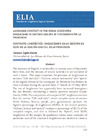Identificador persistente para citar o vincular este elemento:
https://accedacris.ulpgc.es/jspui/handle/10553/77321
| Campo DC | Valor | idioma |
|---|---|---|
| dc.contributor.author | Luján García, Carmen Isabel | en_US |
| dc.date.accessioned | 2021-01-25T16:29:08Z | - |
| dc.date.available | 2021-01-25T16:29:08Z | - |
| dc.date.issued | 2021 | en_US |
| dc.identifier.issn | 1576-5059 | en_US |
| dc.identifier.other | Scopus | - |
| dc.identifier.uri | https://accedacris.ulpgc.es/handle/10553/77321 | - |
| dc.description.abstract | The presence of English is undeniable in various areas of Spaniards' daily lives, and the domain of leisure activities is not excluded of such a trend. This paper examines the presence of Anglicisms in sections: “Life and style”; “Culture, leisure and society” and “Sports” of the digital edition of the newspaper La Provincia (Las Palmas de Gran Canaria) during the period from 1st March to 31st May 2019. The use of Anglicisms has apparently been increased throughout the last decades, considering a similar previous analysis (Luján-García, 1999). The compilation of a corpus of 207 Anglicisms reveals that the section “Life and style”, which compiles news of various fields (fashion, beauty, people, pets, gastronomy) presents the highest percentage of Anglicisms (65.2%). In the second position, “Culture, leisure and society” contains a percentage of 21.7% of the compiled corpus, and this is followed by “Sports”, with 12.9% Anglicisms of the sample. In qualitative terms, some examples of particular uses of the examined Anglicisms are studied in context, considering the whole sentence where they occur, in addition to the analysis of the orthographic markers employed, which tend to be quite inconsistent. Eventually, the pragmatic functions of these Anglicisms are discussed: specialized language, referential, expressive and textual functions, which will be illustrated with examples excerpted from the corpus. | en_US |
| dc.description.abstract | La presencia del inglés es innegable en variadas áreas de la vida cotidiana de los españoles. El terreno de las actividades de ocio no son una excepción a esta tendencia. Este artículo examina la presencia de anglicismos en tres secciones: “Vida y estilo”; “Cultura, ocio y sociedad” y “Deportes” de la edición digital del periódico La Provincia (Las Palmas de Gran Canaria) durante el periodo del 1 de marzo hasta el 31 de mayo de 2019. El uso de extranjerismos y neologismos está presente en el lenguaje periodístico, sin embargo, estos usos parecen haber aumentado a lo largo de las últimas décadas, teniendo en cuenta un trabajo anterior (Luján-García, 1999) sobre el mismo periódico. A través de la lectura diaria del mencionado periódico, se llevó a cabo una recopilación de un total de 207 anglicismos. En términos cuantitativos, la sección de “Vida y estilo”, que abarca noticias de varios campos (moda, belleza, gente, mascotas, gastronomía) presenta el porcentaje más elevado de anglicismos (65,2%). En segunda posición, “Cultura, ocio y Sociedad” ofrece un porcentaje de 21,7%, seguido de “Deportes”, con un 12,9% de la muestra. En términos cualitativos, algunos ejemplos de usos de anglicismos son analizados en contexto, considerando la oraciónen la que aparece, así como el empleo de marcadores ortotipográficos, que presentan una gran inconsistencia. Finalmente, se analizan las funciones pragmáticas de estos anglicismos: lenguaje especializado, función referencial, expresiva o textual. | en_US |
| dc.language | eng | en_US |
| dc.relation.ispartof | Estudios de Linguistica Inglesa Aplicada (ELIA) | en_US |
| dc.source | Elia [ISSN 1576-5059], n. 20, p. 113-146 | en_US |
| dc.subject | 5701 Lingüística aplicada | en_US |
| dc.subject.other | Anglicisms | en_US |
| dc.subject.other | Digital Newspaper | en_US |
| dc.subject.other | Leisure | en_US |
| dc.subject.other | Life And Style | en_US |
| dc.subject.other | Sports Neologisms | en_US |
| dc.subject.other | Anglicismos | en_US |
| dc.subject.other | Prensa digital | en_US |
| dc.subject.other | Neologismos | en_US |
| dc.subject.other | Vida y estilo | en_US |
| dc.subject.other | Ocio y deportes | en_US |
| dc.title | Language contact in the media discourse: Anglicisms in section leisure in the newspaper la provincia | en_US |
| dc.title.alternative | Contacto lingüístico: Anglicismos en la sección de ocio de la edición digital de La Provincia | en_US |
| dc.type | info:eu-repo/semantics/Article | en_US |
| dc.type | Article | en_US |
| dc.identifier.doi | 10.12795/ELIA.2020.I20.05 | en_US |
| dc.identifier.scopus | 85099246434 | - |
| dc.contributor.authorscopusid | 55237963700 | - |
| dc.identifier.eissn | 2253-8283 | - |
| dc.description.lastpage | 146 | en_US |
| dc.identifier.issue | 20 | - |
| dc.description.firstpage | 113 | en_US |
| dc.investigacion | Artes y Humanidades | en_US |
| dc.type2 | Artículo | en_US |
| dc.utils.revision | Sí | en_US |
| dc.date.coverdate | Enero 2021 | en_US |
| dc.identifier.ulpgc | Sí | en_US |
| dc.contributor.buulpgc | BU-HUM | en_US |
| dc.description.sjr | 0,101 | |
| dc.description.sjrq | Q4 | |
| dc.description.esci | ESCI | |
| dc.description.fecytq | Q2 | |
| dc.description.fecytpuntuacion | 32,52 | |
| dc.description.miaricds | 9,8 | |
| dc.description.erihplus | ERIH PLUS | |
| item.fulltext | Con texto completo | - |
| item.grantfulltext | open | - |
| crisitem.author.dept | GIR Estudios sociolingüísticos y socioculturales | - |
| crisitem.author.dept | Departamento de Filología Moderna, Traducción e Interpretación | - |
| crisitem.author.orcid | 0000-0001-7050-777X | - |
| crisitem.author.parentorg | Departamento de Filología Moderna, Traducción e Interpretación | - |
| crisitem.author.fullName | Luján García, Carmen Isabel | - |
| Colección: | Artículos | |
Citas SCOPUSTM
2
actualizado el 08-jun-2025
Citas de WEB OF SCIENCETM
Citations
1
actualizado el 08-jun-2025
Visitas
200
actualizado el 01-nov-2024
Descargas
210
actualizado el 01-nov-2024
Google ScholarTM
Verifica
Altmetric
Comparte
Exporta metadatos
Los elementos en ULPGC accedaCRIS están protegidos por derechos de autor con todos los derechos reservados, a menos que se indique lo contrario.
